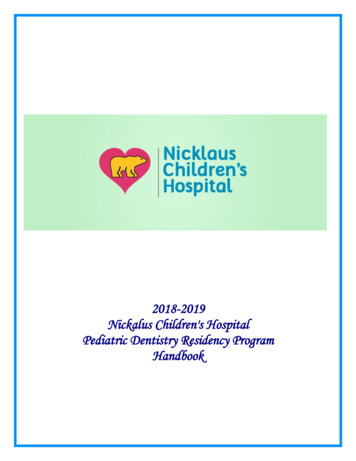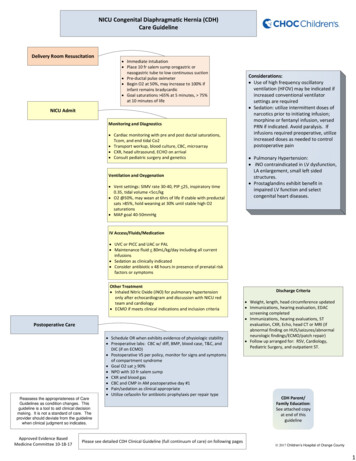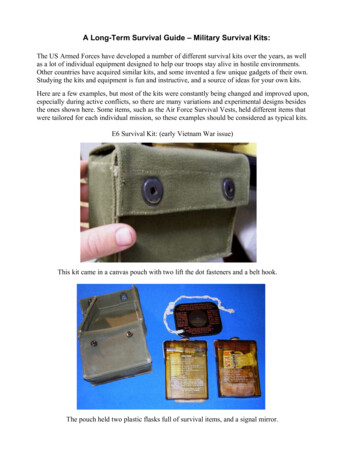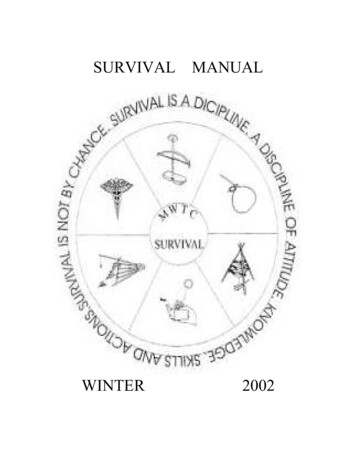
Transcription
NICU SURVIVAL GUIDE(revised June 2011 by Dr. S.Kadiwala & Dr. N.Sharma)This manual, revised for the first time, is designed for use by the pediatric residents and internscreated by residents for the UF-Jacksonville Pediatric Residency Program. Therecommendations in this manual are specific for the practices in this program. Pleaseunderstand that this is not a mini-textbook or outline of general newborn care. The purpose ofthis manual is to assist pediatric house officers by:a) Providing a guideline for management of patients that require immediate attentionb) Reminders to help them in their daily workThere is little discussion of pathophysiology, pharmacology and infectious disease processes.Certain important and common problems are not covered at all. If at any time you are unsureabout the contents provided in this guide, please refer to more comprehensive texts, or contactthe on call attending.1 of 26
Phone NumbersDr. DialDr. GarrisonDr. AlviedoNICU3NStep downL&DLabNemoursAttending call roomNP/PA call 30244-6127244-6040697-3600244-3348244-5109Dr. SharmaDr. BanaderaDr. HuddlestonDr. D. CuevasDr. TanDr. DriscollUF IDGeneticsDr. Spierre dule07001000120014001900Sign-out from Night call/ on-call PARounds (can be later, attending dependant)Noon ConferenceRadiology Rounds (excluding Thursday)Sign-out to Night call/ on call PAExpectationsIf you are on overnight, please double check that your name & pager number are on thewhite board located by the NICU Secretary and in the Step down unit.All orders and notes must have a DATE, TIME, SIGNATURE and DOCTOR NUMBER.Be familiar with the standing ordersAttend afternoon clinicIf you are called about an infant, evaluate/examine and document a note (why you werecalled, your examination, your findings, and what actions were taken).Document any procedures, updates with family, etc. in Neodata (print & place in chart)NICU POLICIES & PROCEDURESInfection ControlScrub for 3 minutes to elbow when first coming into the NICU and Step-Down unitsNo watches or jewelry, except for a plain wedding band while handling patientsPlease keep sleeves at or above your elbows when handling patientsWash hands or use foam before and after handling patientsMust gown and glove (in addition to hand washing) when handling isolated patients2 of 26
Patients with NEC should be considered as having a communicable infection with use ofisolation technique above until proven Rotazyme negativeNO FOOD/DRINKS are allowed anywhere except the nursing/staff lounge – this includeskeeping residents’ computer station clear of food/drinksCharts, including nursing charting material, must remain at the patient’s bedsidePlease follow sterile techniques when introducing central lines/proceduresChart EntriesAll orders and notes must have a DATE, TIME, SIGNATURE and DOCTOR NUMBER.Verbal orders are prohibited except during an emergency such as a resuscitation or whengowned for or performing a sterile procedure.All verbal and telephone orders must be signed before leaving for the day.All read back orders written by the nurse must be co-signedCheck all flagged chart pages for need for signatureOrders “flagged” in chart should be placed face down to comply with HIPPAOtherAny baby transferred to normal nursery must have an interim summary on the chart beforetransfer and either the nursery attending or Patty Willams ANRP notified by telephoneprior to transferPatients returning from surgery must have all orders re-writtenPatients transferred to the Step Down unit must have orders re-writtenAll medication orders must contain the method of dose calculation ie scheduled does and,mg/kg; or for infusions: concentration, mcg/kg/min and mL/kg/min.TPN, Lipids and large fluid volume infusions should be ordered using the TPN programo To access, password is FEEDMERemember not to use banned abbreviations, especially the use of “q.d” and trailing zeroson medication or fluid orders (E.g “5” and not 5.0mg )All parental consents must be signed on admissions or as close to admission as possible3 of 26
PULMONOLOGYVentilator TerminologyPeak inspiratory pressure (PIP)Maximum pressure measured during the delivery of gas during conventional mechanicalventilation.PIP reflects the effects of the amount of gas delivered to the lungs in a given breath (tidalvolume)PEEPPEEP helps to maintain functional residual capacity (FRC). At the end of expiration, thePEEP exerts pressure to oppose passive emptying of the lung and to keep the airwaypressure above the atmospheric pressure. The presence of PEEP opens up collapsed orunstable alveoli and increases the FRC and surface area for gas exchange, thusreducing the size of the shuntRateReflects how often a volume of gas in the system is delivered to the infant.Inspiratory/Expiratory RatioI/E ratio reflects the relationship between time spent in inspiration and time spent inexpriation.If the I/E ratio is 1:2 with a rate of 60 and the total respiratory cycle is 1 second, inspirationis 0.33 second and expriation is 0.66 second.Prolonged inspiration may be associated with more efficient ventilation, optimal arterialoxygenation, a higher risk of air leak, and impending of venous return.Prolonged expriation also improves oxygenation, especially in air-trapping conditionsMean Airway Pressure (MAP)Amount of pressure transmitted to the airway throughout an entire respiratory cycle.Ways to increase MAPo Increase PEEP, or PIP, or Ti, or RR, or FlowMinute Ventilation (Vt)Determines rate of carbon dioxide removalMinute ventilation TVxRRAmplitudeAmount of pressure oscillation that occurs around he MAP.Increasing the amplitude will increase the TV and therefore decrease PCO2.Decreasing the amplitude will decrease the TV and therefore increase PCO2.4 of 26
Mechanical Ventilation and Respiratory SupportTypes of VentsSynchronized Intermittent Mandatory Ventilation (SIMV)Delivers a set number of breaths with a certain amount of pressure each minute,synchronizes with babies’ inspiration attemptsWhen ordering SIMV- write for PIP, PEEP, Rate, IT, and FiO2SIMV/VGVG- Volume guarantees a certain tidal volume, usually 6ml/kg per assisted breath. Targettidal volume maintained by the ventilator as the pressure limit varies inversely with lungcompliance.You still set PEEP and rateAssist ControlNot used much in our NICU, you still must set the PIP and PEEPThe vent assists every breath the baby takes, even if the baby breathes 80 times/minMust set a minimum backup rate in case the baby does not breathe at all.Reserved for very ill neonates who require very high supportPressure Support Ventilation (PSV)Pressure increases in proportion to inspiratory volume.High-Frequency VentilationGoal of HFOV is to reduce barotraumaDelivers a very fast in and out oxygen supply- the baby does not take breaths but there isa continous in and out motion multiple times per minuteGas exchange with a kind of double spiral effect- there is a pulse of O2 going centrallydown the airway with pulses of CO2 going out up the sides of the airway.Main paratemeters are amplitude which affects volume in and out with each oscillation.Mean Airway pressure (MAP) affects expansion and oxgenation of the lungs andfrequency of oscillation (Hz) affecting how many times per minute the exchange occursOscillators vibrate columns of air and have active exhalation cycles. Typically set at 1015Hz (600-900 breaths/min)JET VentilatorUsed if the infant has a pneumothorax, PIE, over/hyperexpanded lungs, pneumatoceles,and severe meconium aspiration/PPHNAllows longer exhalation time vs oscillator (passive exhalation)Change: PIP to change CO2, PEEP (oxygenation & expansion), and rate (expansion)Back up breaths: to treat and correct atelectasis (can increase oxygenation in RDS)Starting Pressures for beginning ventilator supportFiO2:min. to keep Sa02 88%-92% (for premies) and 95% (for term infants)PEEP: 4-6cm waterPIP:14-20cm water (14-16 for premature infants, especially 1000 grams, and 16-18for term infants)Rate:40-60I/E ratio: 1:1-1:2I-time: 0.35-0.45 of 26
Changing Vent SettingsWhat affects Tidal Volume?- PIP, PEEP, and AMPFactorsInc PIPDec PEEPInc AMPTVIncreasesIncreasesNo changeCO2DecreasesDecreasesDecreasesWhat affects respiratory Rate?o Vent Rate increase in rate will decrease CO2o I: E ratio decrease I time will Increase E time which will decrease CO2What affects airway pressure/expansion?FactorsInc PIPInc PEEPInc reasesIncreasesWhat affects O2 concentration?o FiO2o Change oxygenation by either changing FiO2 or PIPo Monitor oxygenation one of three ways SaO2 ABG PaO2 (only accurate on ABG, on VBG or CBG tells you essentiallynothing) CXR- count at least 8 ribsHow to change your PaCO2?VariableIncrease PaCO2Decrease PaCO2Increase PaO2Decrease seNAFiO2NANAIncreaseDecreaseFormulao Remember AMP changes CO2 (increase AMP dec CO2)o MAP changes O2o Extubate MAP 7 and FIO2 35%Formula OI FIO2 x MAP x 100PaO2OI oxygen Index, indicative of severe resp distress, 20 need for Nitric Oxide & 30 ECMOMAP (Ti x PIP) (Te x PEEP)/ Ti Te or [(RR x Ti)/60] x [PIP-PEEP] PEEPBlood GasesTypepHPCO2HCO3CompensationMetabolic Acidosis 7.4 40low-BE (hypervent)6 of 26
Respiratory Acidosis 7.4 40high BE (hypovent)Metabolic Alkalosis 7.4 40high BE (hypovent)Respiratory Alkalosis 7.4 40low-BE (hypervent)Sodium Bicarbonate: investigate cause of metabolic acidosis, e.g. hypovolemia or sepsis, etc.,and treat accordingly. (Refer to Pediatrics - Sodium bicarbonate: basically useless therapy.Aschner JL, Poland RL. Pediatrics. 2008 Oct;122(4):831-5.)Give if adequate ventilation; very seldom indicatedGoal BE -10Give not more than 1 meq/kg/hr, followed by ABG after 1hrFormulamEq Na HCO3 BEx 0.3 x wt (kg)2(¼ correction)mEq NaHCO3 BE x 0.6 x wt (kg)2( ½ correction)Metabolic LowLowDDxOver ventilation, air bubbles, hyperventilationObstructed ET, ET down right main stem bronchus, pneumothorax,PDA, permissive hypercapneaPneumothorax, improper ET position, PDA, atelectasis, lung diseaseAgitation, pneumothorax, improper ETT position, atelectasis,pulmonary HTN, pulmonary edemaCriteria for use of Palivizumab (Synagis)IndicationIndication for the prevention of serious lower respiratory tract disease caused by RSVPotential Candidates for PalivizumabPatient GroupPremature, no chronic lung disease or congenital heart diseaseAge at Start of RSV Season 28weeks gestation age 12months29-32 weeks gestational age 6months with 1 additional riskfactor32-35 weeks gestational age 6months with 2 additional riskfactorChronic Lung Disease 2years7 of 26
Hemodynamically significant congenital heart disease 2yearsOther high-risk children with pulmonary or immune function 2yearsrisk factors: child care, school-age siblings, exposure to environmental air pollution,congenital abnormalities of the airways, or severe neuromuscular diseaseDosage15mg/kg IMGiven every month during RSV seasonApnea 20seconds breathing cessationo Central- no diaphragm activityo Obstructive- upper airway obstruction with diaphragm activityTreatment: Caffeine (see dosing in pharmacology guide)Bronchopulmonary Dysplasia (BPD)Due to arrested lung development resulting from interference with alveolarization andvascularization 36wk, still requiring oxygen at 28daysIf O2 sats 92% and if hypoxia develops chronically, it can cause pulmonary HTN (corpulmonale)Keep CO2 30 on AGB, if less then PVL (periventricular leukomalacia) may developChronic Lung Disease (CLD)/ Bronchopulmonary Dysplasia (BPD)Supplemental oxygen requirement at 28-30 days of life or 36 weeks postmenstrual age.Occurs due to chronic and constant lung injury with ongoing repair and healing of theinjury.Also caused by lung immaturity, oxygen toxicity, and barotrauma/volutrauma (high PIPand PEEP, pneumothorax, and PIE)Meconium Aspiration Syndrome (MAS)Typically occurs in a post term infant whobecomes hypoxic in utero. Fetal asphyxiacauses the anal sphincter to relax and colonicperistalsis ensues expelling meconium intothe amniotic fluid. A second episode ofasphyxia occurs, during which the infantmakes gasping respiratory movements,causing meconium to enter into theoropharynx and lung.o Etiology Atelectasis: due to blockage ofsmaller airway causing air trappingand alveolar collapse Chemical pneumonitis: inflammatoryresponse to meconium8 of 26
Inhibits surfactant function Increases pulmonary vascular resistanceo Diagnosis History CXR: air trapping, hyperexpansion, and hyperinflation; bilateral diffuse, coarse,patchy infiltrateso Treatment During labor: Amnioinfusion Delivery: intubate and tracheal suction in depressed infants (do not stimulatebaby prior to this!)Anytime there is a history of thick meconium at delivery with respiratory distress, obtainhistopathology on the placenta. Meconium staining of placental can determine length oftime (how long prior to delivery) the baby released meconium and was in distress.Air leaksTypes: pneumomediastinum, pneumothorax, pneumopericardium, or subcutaneousemphysemaPulmonary Interstitial Emphysema (PIE)o Occurs when free air is released from ruptured alveolio Diagnosis CXR Fiberoptic probe may reveal hyperlucency of affected sideo Treatment Elevate head 30-40 degrees (this decrease the work of breathing) Give 100% oxygen Needle aspiration and chest tube placementLateral approach- 4th or 6th intercostals spaceSuperior approach- 2nd-3rd IC space or just lateral to midclavicular lineAcute Respiratory Distress Syndrome (RDS)Defined- disease of immature lung anatomy and physiology.Pathologyo Anatomically the preterm lung is unable to support oxygenation and ventilation dueto insufficiently developed alveolar saccules, which causes a deficient surface areafor gas exchange. The volume of surfactant is insufficient to prevent collapse ofunstable alveoli. Because the alveoli collapse with each breath, normal FRC is notestablished.o Increase WOB due to poorly compliant lung and insufficient oxygenation andventilation requiring increased energy output. Increased WOB results in hypoxemiaand academia which cause constriction of pulmonary vascular (arterial) musculature,severely limiting pulmonary capillary blood flow. Without adequate pulmonarycapillary blood flow, the type II pneumocytes become deficient in the precursormaterial necessary for production of surfactant.o Diagnosis CXR- show reduced lung volumes, air bronchograms (visible outlines of air-filledbronchi due atelectasis), reticulogranularity, and lung opacification.o Treatment Surfactant Correct academia9 of 26
Reduce hypoxemia- by maintaining BP and Hct, maintain neutral thermalenvironment.Transient Tachypnea of Newborn (TTN)Etiology- seen in term or near term infants born via C-sectionTTN is due to lack of gradual compression of the chest that eliminates some fluid during anormal vaginal delivery. This causes adelay in reabsorption of normal lung fluidand lung fluid accumulates inperibronchilar lymphatics and thebronchovascular spaces, causing an“obstructive” lung disease. Accumulationof interstitial fluid interferes with the forcesthat hold the bronchioli open, causingcollapse and air trapping.Dx: CXR- show hyperexpansion withstreaky infiltrates radiating from the hilumTx: supplemental oxygenNitric Oxide Treatment Protocol forImprovement of Survival Without BPDEligibilityNote: fluid in fissureo birth weigth/GA groupso 500-799 grams: on NCPAP or ventilatoro 800-1000 grams: if on ventilatoro 1001-1250 grams: if on ventilator and GA 28 0/7weekso postnatal age 7-14dayso Respiratory severity score (RSS MAPx FiO2) 2Exclusionso lethal congenital anomalieso intent to withdraw careo bilateral grad 4 IVHo Target SpO2o recommend 88-94%Treatmento initiate iNO at 20ppm for 96hrs; obtain methemoglobin level at 24hrso wean iNO to 10ppm for 168 hours (7 days)o wean iNO to 5ppm for 168 hours (7 days)o wean iNO to 2ppm for 168 hours (7days)o discontinue iNOo Note: treatment continues even if on nasal CPAP or nasal cannula10 of 26
NUTRITIONTotal Parenteral Nutrition (TPN)Source of nutrition for those who cannot eat adequatelyo Contains a mixture of dextrose, protein, electrolytes, vitamins, and minerals.o Usually the yellow IV bag hanging at the bedsideRouteo Peripheral IV limits Dextrose: 12.5% (12.5 g/100 mL) Calcium: 12meq/L or 300mg/100ml Potassium: 60 meq/L Protein: 2-3%o Central IV (PICC, Broviac/Hickman Port) Dextrose: maximum of 25%Labs (general guidelines –always subject to change based on individual cases)o Prior to starting TPN, check a triglyceride level Goal is to have triglycerides 150mg/dLo Daily chemistry (BMP)o Check magnesium, phosphate, triglycerides q Monday &ThursdayFormulaso Determine Kcal/kg/day Kcal in 24hr period Kcal/kg/24hrWeight (kg)Weight/Age 1500grs/ TermFluidsDOL 0- 80-90mL/kg/dDOL 1- 100-120 mL/kg/dDOL 2- 140-150 mL/kg/dLabsq AM BMPDOL 2 or 3 Tbili/Dbili1000-1500gmDOL 0 -80-100mL/kg/dayDOL 1 -100-200 mL/kg/dDOL2 -120-160 mL/kg/dAt 12hrs of life: BMPDOL 1 Tbili/Dbiliq AM BMP, Hct800-1000gmDOL0- 100mL/kg/dDOL 1 -130 mL/kg/dDOL 2 -150 mL/kg/dDOL0-120 mL/kg/dDOL 1 -130-50 mL/kg/dDOL 2- 150-170 mL/kg/dBMP q8-12hrs x 48hrs, thenDOL1 Tbili/Dbiliq AM BMP, TbiliBMP q8hrs x 48hrs, thenq AM BMP, Hct, TbiliDOL0- 120mL/kg/dDOL 1- 150mL/kg/dDOL 2 -180-200mL/kg/dBMP q8hrs x 48hrs, thenq AM BMP, Hct, Tbili600-800gm 600gmNote, it takes 50-75kcal/kg/day to maintain weight in a thermo-neutral environmentGOAL: 120kcal/kg/day11 of 26
ght/Age BasedMax5-8 mg/kg/day1-2 mg/kg/dayELBW 6-8 mg/kg/minGlucoseconcentration,no more than /- 2%Preterm 4-6 mg/kg/minTerm 4mg/kg/minProtein(watch BUN, Cr)2-3 gr/kg/day0.5-1 g/kg/dayPeripheral line30g/LCentral line4g/LFats (20% IL)(watchtriglycerides)SodiumPotassium(watch UOP)CalciumMgPhosphateTerm: 2 g/kg/dayPreterm: 1 g/kg/day0.8 mEq/kg/dayStart if Na 135Goal 2-4mEq/kg/dayDOL 2 when K 3.51-4mEq/kg/dayDOL 1 with2.5mEq/kg/dayGoal 1.5-2.5mEq/kg/day0.25-0.5 mEq/kg/day0.5-1.5 mEq/kg/day0.5-1g/kg/day4 g/kg/day1-2mg/kg/day1g/kg/day4mEq/kg/dayFluid RequirementsFirst 24hrs of lifeo Start 10W or D7.5 with AA & calcium at 80 kg/day in term infants and 100 mL/kg/dayin preterm infantso D10W 10g/100mL, therefore 1mL D10W 100mg Glucose (1g Dextrose 3.4kcal)Max Volumeo 150-160 mL/kg/day ( 150mL/kg/day is associated with CLD and PDA)o 130mL/kg/day for infant’s with CLDo VLBW infant may need more fluids due to larger surface area, therefore moreinsensible lossTo wean off TPN (general guidelines)Begin enteral feeds on DOL 3 if stable at 20ml/kg/day (20% total volume) q 3hrso Please note: this is a GENERAL rule of thumb, more mature infants can be startedon enteral feeds on DOL 1Advance enteral by 20-30 mL/kg/dayDecrease TPN rate accordingly to maintain overall fluid balanceEnteral FeedsCriteria for oral (PO) feedso 1500 gramso Suck/swallow reflex ( 32-34wk)o Regular stooling pattern, good bowel sounds12 of 26
o No UAC, no NG with bile, no presssorsStart feedso Use breast milk if available (may need to be fortified to meet caloric needs)o Formula should be 20kcal with irono 10-20 mL/kg/day q 3hrsIncrease Feedso Advance PO feeds by 20% per day. Be cautious, aggressive feeding can result in NEC Goal is usually between 150-160 mL/kg/dayo Breast fed infants need to suck well for 10 mins prior to advancingo Advance PO attempts as follows: 1PO attempt/day to 1 PO attempt/shift to 2-3 POattempt/day, PO every other feed, to PO every feed (again, this is a generalguideline)Weight Gaino If gaining weight well on 24kcal formula, consider changing to a 22cal formula 3-4days prior to discharge to ensure continued weight gainHuman Milk Fortifier (HMF)o May add when tolerating 100mL/kg/dayo Add 1pkt/50mL to 22kcal/oz or 1pkt/25mL to 24kcal/ozo HMF increases Ca so if patient has hypercalcemic, add MCT oil to increase calorieso MCT oil can also be used for patients with CLDSupplementso Once on full formula feeds, add: 2-4mg/kg/day of Iron BID Multivitamin 1mL dailyFormula20kcal/oz180mL/kg/day 120kcal/kg/day30mL 0.67kcal24kcal/oz150ml/kg/day 120kcal/kg/day30mL 0.8kcalo After tolerating 100-140mL/kg/day, can change to 24kcal/oz formulao Remember 24kcal/oz formula is ISOtonic and ISOosmolar like 20kcal/ozo 27kcal/oz formula is HYPERosmolar, so use with cautionResidualso Often re-feeding regimen is attending dependento Good rule of thumb If 10% total feeds reefed and continue feeding If 10-30% subtract and refeed If 30% hold feeds and evaluate infant (always consider NEC)o If 20mL worry about intestinal obstruction, if 60mL almost definite intestinalobstructiono If the infant has continued large residuals, look at how the baby is positioned (R sidedown will decrease emptying, while L side down will incease emptying)13 of 26
GASTEROENTEROLOGYGastrochisis vs OmphaloceleGastroschisisOmphaloceleLocationRight of umbilicusCentralUmbilical CordIntactUmbilical cord elementssurround the sac and joinabove the extrusionProtective SacFull-thickness defect, no sacProtective sac is preservedLiver and SpleenRemain within the abdominalcavityPartially extruded in largedefectsAssociated ature regulation- monitor for hypothermiaWrap abdomen in wet dressing to protect and cellophanePlace NG tube to decompress the stomachIntubate to reduce abdominal pressureStart broad spectrum antibioticsObtain stat KUBImmediate Surgical ConsultDuodenal ObstructionPresent- vomiting and abdominal distension, may havehistory of polyhydraminosDx: KUB- double bubble sign (x ray to the left)Tx: NPO, IVF, NG decompression, and surgical repairProximal GI ObstructionVomiting is prominent and distention less prominentDx: KUB and cross table, UGI with SB follow throughTx: NPO, IVF, NG decompression, surgical repairDistal GI ObstructionPresent- abdominal distention, absence or limited passage of stool, feeding intoleranceDx: KUB with cross table reveal multiple loops of dilated bowel, contrast enema mayreveal colonic atresia, microcolon, or meconium plugTx: depends on cause14 of 26
oooIleal or colonic atresia requires surgical repairMeconium plug- rectal stim Q6hrs, glycerin chips,Hirschsprung’s- rectal biopsy, may need full thickness biopsy and ostomy.Meconium IleusPresent- abdominal distension, feed intolerance- vomiting, passage of few (inspissatedmeconium) or no stoolDx: KUB with cross table. Barium enema reveal microcolonTx: Enemas, may need surgeryNecrotizing Enterocolitis (NEC)Present- feeding intolerance with increased gastricresiduals, abdominal distention, heme stools,abdominal wall discoloration. Hypotension,hypothermiaLabs- thrombocytopeniaClassificationo IA- suspected NECo IB/IIA- suspected Definite, mildly ill NECo IIB- definite moderately illo IIA- advanced severely ill, intact bowelo IIIB- advanced, severely ill, perforated bowelTx: NPO, NG decompression, KUB, draw a CBC,test stool for occult blood, serial abdominal exams,Surgical consultPneumatosis intestinalisDiagnostic CategorySuspected NECDefinite NECAdvanced NECSystemic illnessTemperature & glucoseinstability, increasedepisodes of apena/bradyMild to moderatesymptomsShock like picture withpossible hypotensionAbdominal symptomsIncreased gastric residuals,abdominal distension,occult or grossly bloodystoolsAbdominal distension& tenderness, absentbowel soundsMarked distension,peritoneal signsMetabolic acidosis,thrombocytopeniaMetabolic & respiratoryacidosis, DICPneumatosisintestinalis; portalvenous gasPneumoperitoneum ifperforatedLabsImagingNormal to mild distention;bowel wall thickening;possibly a fixed dilated loop15 of 26
HEMATOLOGYPolycythemiaDefined as Hct 65%, that is seen in neonates exposed to chronic hypoxia in utero, or adelay in cord clampingRisks- hyperviscosity, sludgingPresent- hypoglycemia, ruddy complexion, irritableConfirm peripheral stick value with central blood sampleTreatment is by partial exchange transfusionTransfusionsWhen to Transfuseo Hct 25, asymptomatic with a retic 1%o Hct 30, with: 35% on Oxy hood, CPAP/Mech vent with MAP 6 Significant episodes of apnea/bradycardia ( 9 in 12hrs or 2 that require morethan moderate stimulation to recover) Persistent HR 180 or RR 80 over 1day 10g/d weight gain over 4days when receiving 100kcal/kg/day Pre-opo Hct 35 35% on oxy hood CPAP/Mech vent with MAP 6-8o Hct 40 On ventilatorPRBCo 15-20mL/kg over 3-4hrso Draw post-transfusion H/H 4hrs after transfusion (especially if no labs scheduled forthe morning, or if infant is extremely unstable/critical)o If the infant is 1kg, order “DESIGNATED UNIT” on pink slip held for 35days from1st draw dateo 2mL/kg PRBC will increase Hgb by 1g/dLAnemia of prematurityNadir is usually seen at 4-6wks of lifeo Supplement with iron when on full feeds Some attendings may choose to start Epopoetin Taper epo dose if Retic 7, and discontinue when infant is 1800gmo Check Hct and Retic q MondayPlateletsPlateletphoresis of 15-20mL/kg IV (platelets “drop” in, therefore no time requirementneeded on orders)Check 4hr post transfusion level (especially if no labs scheduled for the morning, or ifinfant is extremely unstable/critical)Transfuse if 20k or 50k with active bleedingPre-op16 of 26
OPHTHALMOLOGYRetinopathy of Prematurity (ROP)Occurs when there is disruption of the normal progression of retinal vascular developmentin the preterm infant which results in abnormal proliferation of blood vessels in thedeveloping retina (neovascularization). ROP develops in 84% of preterm infants 28wks.Etiologyo Pregnancy complications (HTN, DM, smoking)o Supplemental oxygen (oxygen radicals produced)o Anemia: decrease in oxygen-carrying capacity, results in increased FiO2 to maintainadequate oxygenation, thus exposing the lung/retina to more oxygen/oxygen toxicity.o Apnea/Bradycardia: causes repeated cycles of hypoxia/hyperoxia andhypocapnia/hypercapnia exposing retinal vessels to alternating ischemia andhyperoxic toxicity.Degree of retinal vascularizaiton at birth determines an infant’s susceptibility to ROPScreen for ROP if the infant has one of the following:o Birth weight 1500 g or 30wko Birth weight between 1500-2000 g with unstable clinical courseo Exam shall be done at 32 weeks post conception on average If gestational age at birth is between 22-27 weeks, schedule the first ROP examat 31 weeks If gestational age at birth is 28 weeks, schedule the first ROP exam at 32 weeks If gestational age at birth is 29 weeks, schedule the first ROP exam at 33 weeks If gestational age at birth is 30 weeks, schedule the first ROP exam at 34 weeks If gestational age at birth is 31 weeks, schedule the first ROP exam at 35 weeks If gestational age at birth is 32 weeks, schedule the first ROP exam at 36 weeksPre-exam medso Cyclomydril (cyclopentolate/phenylephrine) 1drop OU Q5min x3, give 1hr prior toexamo 0.5% Tetracine at bedside Follow up scheduleFollow up 1wk or less1-2wk Follow up2wk Follow up2-3wk Follow upStage I or II with Zone IStage 3 ROP Zone IIImmature Vascularization, Zone I, no ROPStage 2 ROP- Zone IIRegressing ROP, Zone IStage I ROP, Zone IIRegressing ROP, Zone IIImmature vascularization, Zone II, no ROPStage 1 or 2 ROP, Zone IIIRegressing ROP,Zone IIIZoneso Plus Disease - degree of dilation and tortusoity of the posterior retinal blood vessels17 of 26
ooPrethreshold- zones1-2 any stageThresholdblindnessapproximately 50%Stages of ROPFigure from J Bernbaum. Preterm Infants in Primary Care: A Guide to Office Management, 2000.18 of 26
CARDIOLOGYFetal Circulation and BirthIn the fetus, pulmonary vascularresistance is high, and pulmonary arteryblood pressure systemic bloodpressure, causing blood flow from themain pulmonary artery to travel throughthe open ductus arteriosus to thedescending aorta. A second right-to-leftshunt occurs across the foramen ovale inthe fetus.Pulmonary vascular resistance is high inthe normal fetal “hypoxemic” state, whichmeans that pulmonary vascularresistance and pulmonary artery bloodpressure decrease as the PaO2 of theneonate increases. At birth, the ductusarteriosus actively constricts in responseto the increase in PaO2, eliminating bloodflow across the ductus and completingthe transition to neonatal circulation.During hypoxemia, the pulmonary vasculature vasoconstricts raising pulmonary vascularresistance, thus relaxing the vasculature of the ductus arteriosus and allowing blood flowfrom pulmonary artery to the descending aorta.Patent Ductus Arteriosis (PDA)Allows blood from right ventricle (RV) and pulmonary arterial system to flow intodescending aorta (thereby bypassing the pulmonary circulation). The PDA closes quicklyafter birth (hours to several days).Physical Exam Findings:o Holosystolic murmur heard at 2nd or 3rd intercostals space at left sternal boardero Bounding peripheral pulseso Hypotension- decreased mean arterial pressure (MAP)o Respiratory deterioration- TachypneaDiagnosiso ECHO (Gold Standard) Perform pre and post treatment of PDAo CXR may show cardiomegaly with increased pulmonary vascularity in large shunts.Treatmento Indomethacin or Ibuprofen Monitor urine output (UOP) during treatmento Respiratory support (may need to be intubated)o Fluid restrictiono A Hct 40% will decrease L to R shuntingCoarctation of the AortaLocalized constriction of the aorta that usually occurs at thejunction of the transverse aortic arch and the descending19 of 26
aorta in the vicinity of the ductus arteriosus. Coarctation can occur anywhere in the aortafrom above the aortic valve to the abdominal aorta.Diagnosiso Blood pressures in all four extremities.o SBP 15mmHg in upper extremitie
NICU SURVIVAL GUIDE (revised June 2011 by Dr. S.Kadiwala & Dr. N.Sharma) This manual, revised for the first time, is designed for use by the pediatric residents and interns created by residents for the UF-Jacksonville Pediatric Residency Program. The recommendations in this manu










